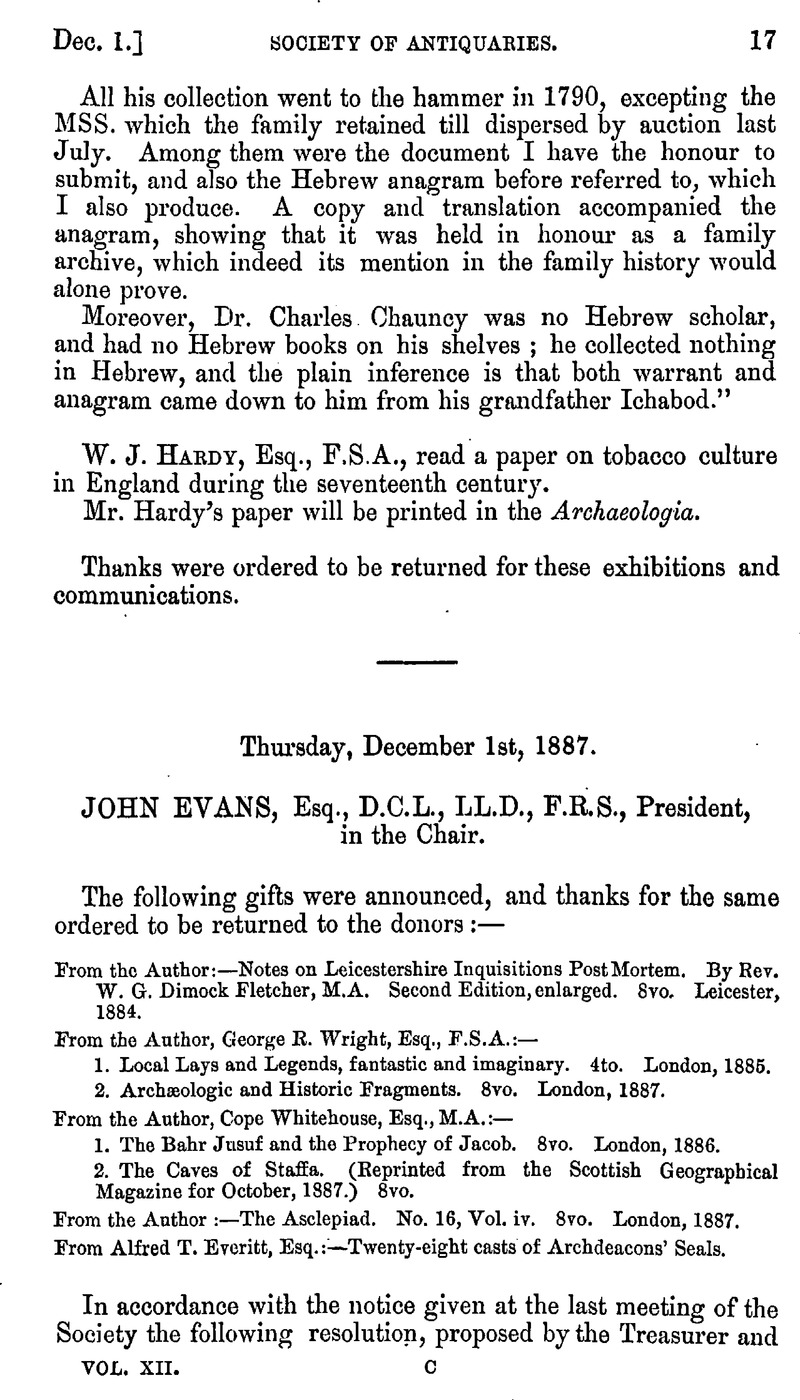No CrossRef data available.
Article contents
Thursday, December 1st, 1887
Published online by Cambridge University Press: 10 May 2010
Abstract

- Type
- Proceedings
- Information
- Copyright
- Copyright © The Society of Antiquaries of London 1889
References
page 19 note * The words in italics are written in gold in the original.
page 20 note * Edward Norgate, commemorated by Fuller in his Worthies. by Horace Walpole, by Mr. Sainsbury and others, as among the most conspicuous of the minor artists of the reigns of James I. and Charles I., seems to have been an extremely busy person. His skill in the embellishment of manuscripts occasioned his appointment as illuminator of royal patents and writer of royal letters to foreign sovereigns. Some of these addressed to the King of Persia, the Emperor of Russia, the Grand Signor or Great Mogul, were ornamented with illuminated initial letters and fanciful scroll borders, which are said to have been of very high merit. Norgate was also Windsor Herald, and adorned pedigrees and grants of peerages with exquisite specimens of his talents, &c.— Notes and Queries, 3d S. xi. p. 11.
page 21 note * See Report on these excavations, Archaeologia Cambrensis for 1887.
page 23 note * Arch. Camb. 3rd S. Vol. ix. p. 344.
page 23 note † Wright, The Celt, the Roman, and the Saxon, p. 144.
page 23 note ‡ Ibid. 3rd S. Vol. ix. p. 320.
§ Arch. Camb. 3rd S. vol. iv. p. 320.
‖ Ibid. 3rd S. vol. vii. p. 309.
page 24 note * Arch. Camb. 4th S. vol. ix. p. 326, vol. x. p. 56.
page 26 note * Arch. Camb. 3rd S. vol. vii. p. 312.
page 26 note ‡ Ibid. 4th S. vol. x. p. 81.
page 26 note † Ibid. 4th S. vol. ix. p. 353.
page 27 note * In a discussion that took place upon this paper, the President, Dr. Evans, suggested the head was of yew, alluding to the fact that yew in a fairly preserved state has been found in the Swiss lake dwellings.
page 27 note † Arch. Camb. 4th S. vol. ix. p. 353.
page 29 note * See similar design on tile found in London. Wright, The Celt, the Roman, and, the Saxon, p. 156.
page 30 note * See a similar one in The Celt, the Roman, and the Saxon, p. 155.
page 30 note † Subsequently taken away by Mr. Rogers, of Abermeurig.
page 30 note ‡ Wright, in The Celt, the Roman, and the Saxon, pp. 155, 156, gives figures of tiles from Dover (Dubris), which are of the same shape and similar to these tiles. A flanged tile figured on p. 156 has the circular mark referred to above ; this tile came from London. He adds that tiles from South Wales have the inscription LEGIIAVG (Legio 2a Augusta). None with this mark have as yet been found at Llanio. The cross-work and the cross are figured, pp. 154, 155, as being marked on the facing of the stone of Hadrian's wall. Mr. Wright adds, the tiles are always scored in patterns of great variety apparently for the purpose of being fixed more tenaciously by the mortar.
page 33 note * Arch. Camb. 4th S. vol. ii. p. 263.
page 33 note † Ibid. 3rd S. vol. vii. 1861, p. 312.
page 34 note * Arch. Camb. 3rd S. vol. vii. p. 312.
page 34 note † The three letters THA are conjoined.
page 35 note * Arch. Camb. 4th S. vol. iv. p. 116, note.
page 35 note † See plate 71, fig. 8.
page 37 note * Arch. Camb. 3rd S. vol. vii. p. 310.
page 38 note * Arch. Camb. 4th S. vol. ix. p. 334.
page 40 note * This short note on the history and uncovering of the base of the serpent is chiefly taken from Sir Charles Newton's work above referred to.




